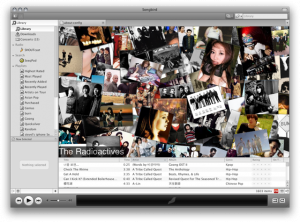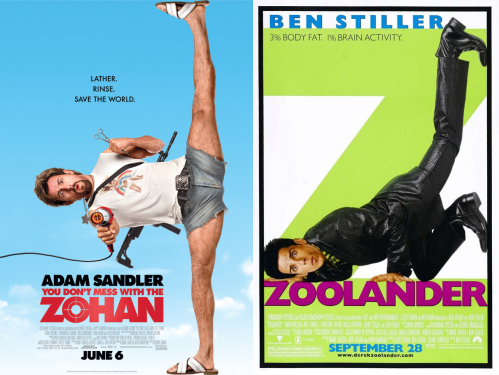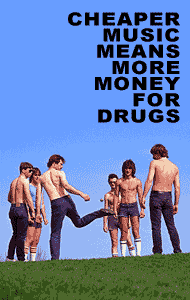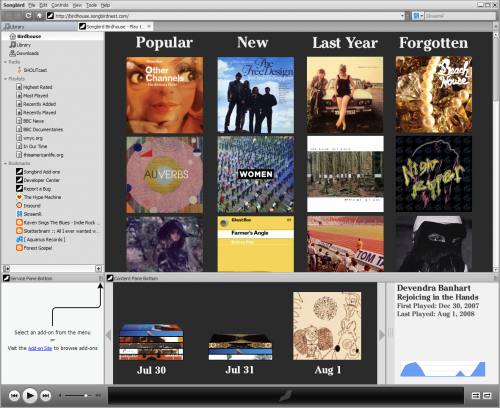Year: 2008
Typography in Ubuntu 8.10 Intrepid Ibex
One thing I’ll never understand is why Ubuntu ships with such hideous default system fonts, when there are some perfectly great open source fonts built right into it. For instance, UnDotum is a near-exact clone of Franklin Gothic, although strangely a Google search for undotum “franklin gothic” only turns up one page that mentions the two together. It seems to be an arbitrary similarity, as the purpose of UnDotum and other UnFonts is to provide Korean characters. Anyway, it makes a good window title font.
Then there’s Nimbus Sans, which is indistinguishable from Helvetica; DejaVu Sans, which as far as I can tell is a descendant of Frutiger (and, hence, a cousin of [Apple’s] Myriad and [Microsoft’s] Segoe UI), and makes a nice all-around system font; and Libertine, which makes for a great general-purpose body serif. Once you set these as the fonts in GNOME and in Firefox, everything looks scores better — better than Ubuntu’s default look, certainly, and arguably better than Windows.
Video: That MTV “Vertebrae” Commercial
Hey, I didn’t say it was good.
I guess what I find so fascinating about it is: When did MTV ever condone being unpopular? Between the Spring Break programming and drunk girls crying on The Real World, it was an odd change of pace, but one that reminded me of the attitude MTV used to have, in the ’80s, before they became shameless culture-mongers. Still, it’s important not to ignore that this guy actually is attractive, and dressed fashionably, and — at least at my school — probably would have been popular. I guess it would have turned too many viewers off to have presented him as acne-ridden, overweight, without any sense of style, and listening to black metal?
Something I forgot to mention last time is that this was part of a series of commercials, if I remember correctly, that played on the “V” in “MTV,” although I forget the titles of the other installments.
Thanks to La fille des montagnes (“The girl mountain”?) for sending me the video.
Alphabetization: Part III
 In what I think may be the first truly novel browsing environment developed for Songbird, ♪Photo displays your library as a pile of artist photos pulled from Last.fm. They can be dragged around and rearranged, and their orientation is remembered between Songbird sessions. In my testing it is unusably slow, however it is remarkably exciting to see innovation like this before Songbird is even out of beta. It would be an easy matter to implement a “snap” feature that would cluster similar artists together based on Last.fm data, or to provide an alternate view by album cover rather than artist photo — honestly, who can recognize some of these artist photos?
In what I think may be the first truly novel browsing environment developed for Songbird, ♪Photo displays your library as a pile of artist photos pulled from Last.fm. They can be dragged around and rearranged, and their orientation is remembered between Songbird sessions. In my testing it is unusably slow, however it is remarkably exciting to see innovation like this before Songbird is even out of beta. It would be an easy matter to implement a “snap” feature that would cluster similar artists together based on Last.fm data, or to provide an alternate view by album cover rather than artist photo — honestly, who can recognize some of these artist photos?
Anyway, as it’s only a couple weeks old I’m sure it will improve, and it demonstrates just what amazing things can be done with the Songbird platform. Hopefully we’ll see more daring and clever extensions like this when Songbird hits 1.0 next month. I’m considering making it my full-time player in order to collect more statistics (play dates, play counts, added dates, etc.).
Zohander

Matador Midline Classics
 “Cheaper music means more money for drugs.” I can’t believe I found it!
“Cheaper music means more money for drugs.” I can’t believe I found it!
Years ago, I used to see this ad all over Pitchfork. I thought it was funny that a label would so openly and so mechanically condone drug use; the image was memorable; and it really did make me want to go record shopping — the bands they name are such stalwarts and hearken back to the golden years of Matador in the ’90s, even though most are still making music today, reminding me of a time when people did primarily buy music, not download it. It was effective enough anyway that I had to go hunting to find it. I thought I had thoroughly scoured the Internet Archive Wayback Machine, but I had apparently missed this page, along with seven others that contained the ad, from May to June of 2004. I’m sure it was in truth thrown together in a rush and they weren’t especially proud of it at Matador.
I just need to start saving everything I am mildly amused by in passing.
The Abyss
You might remember this 1989 James Cameron movie.

Yeah that one. I caught up with it about halfway through last night, and I don’t think I’d seen it in maybe a dozen years. I remember having wanted to like it as a kid, as I was into stuff like aliens and Atlantis, but I also remember feeling as though the underwater intelligences were hardly emphasized, almost as an afterthought, and that the main plot revolved around some boring adult drama stuff blah blah Cold War. And also that the ending was horribly unsatisfying.
Man, I was right, especially about the ending. Okay so the final plot point is that Ed Harris needs to go like four miles deeper than their submarine already is, by himself, in just a diving suit whose helmet won’t implode because it’s filled with pink breathing fluid instead of air. They claim that it’s similar to the stuff you breathed “for nine months” in the womb, but I thought oxygen was supplied by the umbilical cord? At any rate, down he goes, until he’s greeted by one of these non-terrestrial intelligences who just kind of glows and blinks at him for a while before taking his hand and leading him to this grand underwater city.
Earlier we had seen what we assumed to be a ship belonging to these guys, though it was fluid and seemingly bioluminescent. One of the crew had suggested that “their whole technology” is based on manipulating water, so okay, I can suspend belief enough for that, it’s a cool idea anyway. So as Ed Harris and this alien are careening through this underwater city we imagine, Okay, maybe these skyscraper-like structures are made of water, whether they freeze it or otherwise fix it molecularly by ionizing it or something?, look, I’m not a chemist.
Alphabetization: Part II
First, some good news: Songbird is now in public beta! It’s amazing how stable things have gotten just over the last six months. And, significantly, it now features a Playback History API, which by the looks of things allows developers access to the entire play history of any song in a library, something that is crucial to the kind of deep library scavenging I’ve been pining for.
Since I last wrote, everything I see or read seems to inspire my half-baked ideas about the better ways we can browse our unmanageably large music libraries. After telling a friend about these ideas, he said:
Yeah, it’s actually really frustrating. I intentionally keep the number of artists on my iPod small so I don’t have to sort to find things I’m currently into.
Me too.
Then there are the people who are doing a lot of (real) work towards novel interfaces like the (hypothetical) ones I’m describing; Last.fm’s “Islands of Music” (explained here) demonstrates the kind of artist-similarity topology that would make browsing your library a more pleasant experience; Lee Byron explains in more detail how he developed that Last Graph infovis; necimal releases a Music Recommendations extension for Songbird that promises to use Last.fm’s data to find within your library artists similar to the one playing; and the Aurora project, part of the Mozilla Labs concept browser series, depicts a radical three-dimensional view of files and data with auto-clustering, which, if applied to a music library, would be nothing short of incredible.
I’ve also thrown together a pitiful little mock-up of what Songbird might look like when you start it up with the kind(s) of extensions I’m hoping for:
The two core components depicted are the Start Page and the Timeline View. The Start Page I feel would be seriously valuable, one of the ideas behind all these blatherings of course being that one doesn’t always have a destination in mind when opening their music library. The Start Page would offer a number of convenient “jumping-off” points, pulling you into your library to explore it further — by artist similarity, maybe, or by play history proximity, after just a couple clicks.
The Timeline View is a zoomable timeline, shown here zoomed to a daily view. Zooming out could show you albums played within recent weeks; then months, quarters, etc. These albums might be sorted by Periodical Impact, something I explained in depth here; essentially they would be sorted not by the raw number of times they were played within any given period, but by how distinct they were to that period.
Even these meager ideas are leagues ahead of what’s available, and I’m not even a data analyst. Just imagine how a library’s play history data could be exploited by somebody trained in these things.
